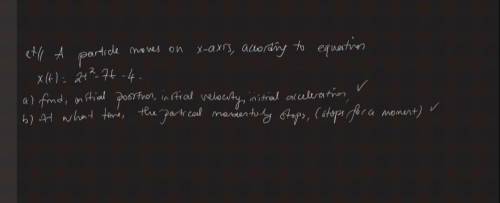
Physics, 04.01.2021 14:00 alwaysneedhelp84
(you see the equation attached.)
Q- find initial position, initial velocity, initial acceleration.
Q2- at what time the particle momentally stops


Answers: 3


Other questions on the subject: Physics

Physics, 21.06.2019 22:00, greenclonetroop6q2tg
Arock collection comes from which part of earth?
Answers: 1

Physics, 22.06.2019 10:50, infinitexero1022
Two rigid transformations are used to map δhjk to δlmn. the first is a translation of vertex h to vertex l. what is the second transformation? a reflection across the line containing hk a rotation about point h a reflection across the line containing hj a rotation about point k
Answers: 1

Physics, 22.06.2019 12:10, lks715
Point charges q1 = 51 µc and q2 = −27 µc are placed 1.0 m apart, with q2 on the right. what is the force (in n) on a third charge q3 = 19 µc placed midway between q1 and q2? (assume the positive direction is to the right. indicate the direction with the sign of your answer.)
Answers: 3

Physics, 22.06.2019 17:00, jenn8055
In the future, people will only enjoy one sport: electrodisc. in this sport, you gain points when you cause metallic discs hovering on a field to exchange charge. you are an electrodisc player playing the popular four disc variant. the disks have charges of qa = −8.0 µc, qb = −2.0 µc, qc = +5.0 µc, and qd = +12.0 µc. (1) you bring two disks together and then separate them. you measure the resulting charge of these two disks and find that it is +5.0 µc per disk. which two disks did you bring together? (a) a and b (b) a and c (c)a and d (d)b and c(e) b and d (f) c and d. (2) you bring three disks together and then separate them. you measure the resulting charge of these three disks and find that it is +3.0 µc per disk. which three disks did you bring together? a, b, and c (a) a, b, and d (c) a, c, and d (d) b, c, and d. (3) given the resulting charge of each disk measured in (b) is +3.0 µc, how many electrons would you need to add to a disk of this charge to electrically neutralize it? electrons
Answers: 3
You know the right answer?
(you see the equation attached.)
Q- find initial position, initial velocity, initial acceleration.<...
Questions in other subjects:






Social Studies, 02.10.2019 20:50


Mathematics, 02.10.2019 20:50


Health, 02.10.2019 20:50



